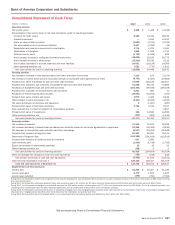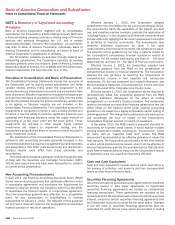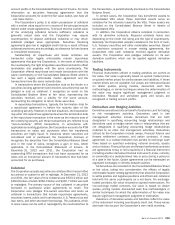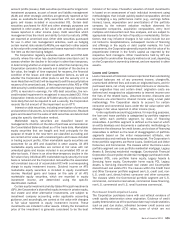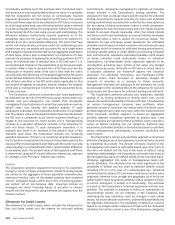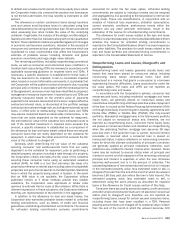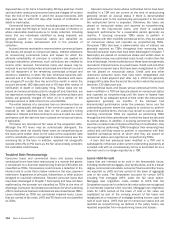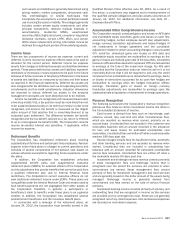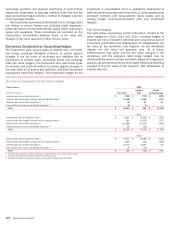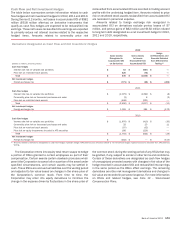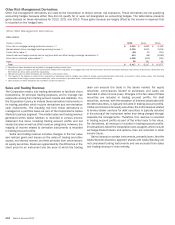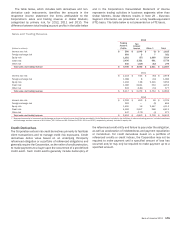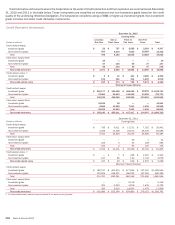Bank of America 2012 Annual Report Download - page 169
Download and view the complete annual report
Please find page 169 of the 2012 Bank of America annual report below. You can navigate through the pages in the report by either clicking on the pages listed below, or by using the keyword search tool below to find specific information within the annual report.Bank of America 2012 167
such assets and liabilities is generally determined using
pricing models, market comparables, discounted cash
flow methodologies or similar techniques that
incorporate the assumptions a market participant would
use in pricing the asset or liability. This category generally
includes certain private equity investments and other
principal investments, retained residual interests in
securitizations, residential MSRs, asset-backed
securities (ABS), highly structured, complex or long-dated
derivative contracts, certain LHFS, IRLCs and certain
CDOs where independent pricing information cannot be
obtained for a significant portion of the underlying assets.
Income Taxes
There are two components of income tax expense: current and
deferred. Current income tax expense reflects taxes to be paid or
refunded for the current period. Deferred income tax expense
results from changes in deferred tax assets and liabilities between
periods. These gross deferred tax assets and liabilities represent
decreases or increases in taxes expected to be paid in the future
because of future reversals of temporary differences in the bases
of assets and liabilities as measured by tax laws and their bases
as reported in the financial statements. Deferred tax assets are
also recognized for tax attributes such as net operating loss (NOL)
carryforwards and tax credit carryforwards. Valuation allowances
are recorded to reduce deferred tax assets to the amounts
management concludes are more-likely-than-not to be realized.
Income tax benefits are recognized and measured based upon
a two-step model: first, a tax position must be more-likely-than-not
to be sustained based solely on its technical merits in order to be
recognized, and second, the benefit is measured as the largest
dollar amount of that position that is more-likely-than-not to be
sustained upon settlement. The difference between the benefit
recognized and the tax benefit claimed on a tax return is referred
to as an unrecognized tax benefit (UTB). The Corporation records
income tax-related interest and penalties, if applicable, within
income tax expense.
Retirement Benefits
The Corporation has established retirement plans covering
substantially all full-time and certain part-time employees. Pension
expense under these plans is charged to current operations and
consists of several components of net pension cost based on
various actuarial assumptions regarding future experience under
the plans.
In addition, the Corporation has established unfunded
supplemental benefit plans and supplemental executive
retirement plans (SERPs) for selected officers of the Corporation
and its subsidiaries that provide benefits that cannot be paid from
a qualified retirement plan due to Internal Revenue Code
restrictions. The Corporation’s current executive officers do not
earn additional retirement income under SERPs. These plans are
nonqualified under the Internal Revenue Code and assets used to
fund benefit payments are not segregated from other assets of
the Corporation; therefore, in general, a participant’s or
beneficiary’s claim to benefits under these plans is as a general
creditor. In addition, the Corporation has established several
postretirement healthcare and life insurance benefit plans.
In connection with a redesign of the retirement plans, on
January 24, 2012, the Corporation froze benefits earned in the
Qualified Pension Plans effective June 30, 2012. As a result of
this action, a curtailment was triggered and a remeasurement of
the qualified pension obligations and plan assets occurred as of
January 24, 2012. For additional information, see Note 18 –
Employee Benefit Plans.
Accumulated Other Comprehensive Income
The Corporation records unrealized gains and losses on AFS debt
and marketable equity securities, gains and losses on cash flow
accounting hedges, certain employee benefit plan adjustments,
foreign currency translation adjustments and related hedges of
net investments in foreign operations and the cumulative
adjustment related to certain accounting changes in accumulated
OCI, net-of-tax. Unrealized gains and losses on AFS debt and
marketable equity securities are reclassified to earnings as the
gains or losses are realized upon sale of the securities. Unrealized
losses on AFS securities deemed to represent OTTI are reclassified
to earnings at the time of the impairment charge. For AFS debt
securities that the Corporation does not intend to sell or it is not
more-likely-than-not that it will be required to sell, only the credit
component of an unrealized loss is reclassified to earnings. Gains
or losses on derivatives accounted for as cash flow hedges are
reclassified to earnings when the hedged transaction affects
earnings. Translation gains or losses on foreign currency
translation adjustments are reclassified to earnings upon the
substantial sale or liquidation of investments in foreign operations.
Revenue Recognition
The following summarizes the Corporation’s revenue recognition
policies as they relate to certain noninterest income line items in
the Consolidated Statement of Income.
Card income is derived from fees such as interchange, cash
advance, annual, late, over-limit and other miscellaneous fees,
which are recorded as revenue when earned, primarily on an
accrual basis. Uncollected fees are included in the customer card
receivables balances with an amount recorded in the allowance
for loan and lease losses for estimated uncollectible card
receivables. Uncollected fees are written off when a card receivable
reaches 180 days past due.
Service charges include fees for insufficient funds, overdrafts
and other banking services and are recorded as revenue when
earned. Uncollected fees are included in outstanding loan
balances with an amount recorded for estimated uncollectible
service fees receivable. Uncollected fees are written off when a
fee receivable reaches 60 days past due.
Investment and brokerage services revenue consists primarily
of asset management fees and brokerage income that is
recognized over the period the services are provided or when
commissions are earned. Asset management fees consist
primarily of fees for investment management and trust services
and are generally based on the dollar amount of the assets being
managed. Brokerage income is generally derived from
commissions and fees earned on the sale of various financial
products.
Investment banking income consists primarily of advisory and
underwriting fees that are recognized in income as the services
are provided and no contingencies exist. Revenues are generally
recognized net of any direct expenses. Non-reimbursed expenses
are recorded as noninterest expense.


